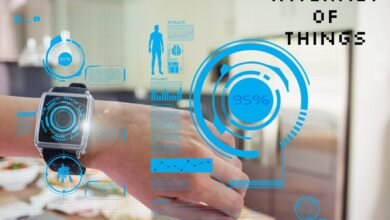Smart Clothing Powered by IoT Technologies Enhancing Health and Fitness
Discover how IoT-powered smart clothes are transforming health and fitness with real-time tracking, biometric data, and next-gen wearable technology.

Welcome to the future of wearable technology embedded right into what you wear. Smart clothes are the next revolution in health and fitness supervision, providing an integrated, painless experience that is much more than just counting steps or heartbeat. Driven by the Internet of Things, these smart clothes communicate with a larger digital environment, providing ongoing, real-time feedback into the body’s functioning and state of well-being. This article delves into how smart clothing enabled by IoT is revolutionising health and fitness, from biometric tees to posture-adjusting fabrics, innovation at your doorstep.
Understanding Smart Clothing
Smart clothing is defined as any product with technology embedded in it, such as smart textiles, micro-sensors, or data processing units that can log physical activity, track vital health information, and respond to environmental change. Smart clothing does not just provide fitness tracking, but tracking in real-time, which includes heart rate, respiration, muscular activity and posture. The components include smart fabrics that are capable of conducting electricity, embedded sensors capable of collecting physiological or environmental information, and embedded modules that process and transmit this data.
The Internet of Things is used as the glue that allows wellness practitioners or the user to receive feedback remotely and instantly. Whether it is fitness-enhancing workout gear or clothing for posture correction, or temperature-regulating clothing, smart clothing is giving new options for monitoring and managing our health.
Anatomy of Smart Clothing: Where Fashion Meets Functionality

Sensors Embedded in Fabric
Smart clothes depend on a mix of tools that are carefully sewn into the cloth, making the tech nearly invisible and easy to wear. Some sensors, like biometric sensors, help to keep track of important signs like heartbeat, respiration and body temperature, giving key data for health checks. Motion sensors find out physical action position and walking style, helping users improve exercises or fix their stance. Also, environmental sensors can check things like sun exposure and air condition, making sure wearers know about their area. These tools team up to collect full up-to-the-minute deta͏ils about both the wearer in addition to their space
Actuators
While sensors take in information, actuators enable intelligent clothing to actively react to that data. These pieces of equipment can initiate physical responses or alerts based on input from sensors. Certain clothing supplies haptic feedback in the form of subtle vibrations to alert the user to critical health notices or reminders. Others consist of temperature-control pieces that adapt the fabric insulation, cooling or warming the user as required. Actuators introduce an interactive element to intelligent clothing, converting passive monitoring into dynamic, real-time feedback.
IoT Backbone
The Internet of Things is an essential communication network that connects smart clothing to the Internet, or the digital world. Smart clothing embedded sensors send to IoT through various wireless methods such as Bluetooth, Wi-Fi, Cellular, etc., which forward their data to central locations like smartphones or cloud servers, wherein it can be stored, processed, or accessed at any time. IoT facilitates continuous real-time data transmission, allowing the user and health care professional to view performance or health condition in real time and monitor and track around the clock, everywhere. Without the IoT, smart clothing would only be able to collect simple, isolated data.
Data Processing and Integration with Artificial Intelligence
After data is transferred, raw data from smart clothing is processed with artificial intelligence and machine learning algorithms that will extract complex patterns, highlight trends, and identify anomalies that are difficult to identify from raw numbers. AI can inform a user of signs of fatigue, dehydration, and bad posture and make personalised suggestions to optimise health and fitness outcomes. This smart data processing is one that enhances smart clothing from basic data collectors to useful devices that provide meaningful insights, which enable people to make intelligent decisions about their health.
Applications of Smart Clothing in Health and Fitness:
Personal Health Monitoring
Smart wear uses the underlying sensors to collect accurate information about the heart rate, body temperature, posture and even blood sugar, including blood sugar. Smart wear allows users to get personalised feedback on the state of their body, so users can sense abnormalities before they escalate, and make corrective health decisions. Continued monitoring permits users to discover how their body reacts to different types of activities and conditions and adjust their health accordingly.
Enhanced Fitness Tracking
Athletes and fitness enthusiasts reap much from smart exercise wear such as compression clothes and running shoes, which monitor workouts, fatigue, and general performance. Through monitoring patterns of movement and muscle stress, these clothes assist in optimising training sessions, enhancing stamina, and avoiding overtraining. Real-time feedback allows users to modify intensity or technique for optimal results.
Prevention of Injury and Recovery
Smart clothes are important for the prevention of injury as they monitor the muscle stress of a person and provide corrective feedback while exercising. For example, there are posture-correcting t-shirts that notify the user about improper alignment; therefore, a user has a lower risk of muscle strain or sprain in the performing posture. After a workout, there are smart garments that provide therapeutic benefits to the user (e.g. muscle massage or compression therapy) could also speed up the overall recovery time and soreness.
Sleep and Well-being Tracking
Some smart clothing monitors sleep quality and general wellness parameters, aiding users to maximise recovery and sustain a healthy balance. Through the observation of sleep patterns, breathing, and motion, such clothes provide insights that are likely to enhance rest cycles and facilitate mental and physical rejuvenation.
Some Challenges and Ethical Issues: The Way Forward
Even as cutting-edge and promising as IoT-enabled smart garments are, it is beset by some practical and ethical issues that need to be resolved before mass adoption is possible.
Privacy and Data Security
Perhaps the most critical issue is the management of sensitive health information. Smart clothes constantly collect detailed personal data, transmit it to smartphones, cloud services, or healthcare systems. Without strong encryption and safe data management practices, it is vulnerable to data violations or misuse. Ethical issues also arise around data ownership and consent, calling for open policies and user control over personal data.
High Energy Consumption
Many smart clothes require constant power to maintain sensors and provide wireless transmission, but long battery life in flexible, wash-dry fabrics presents a technical challenge. Charging frequently or carrying bulky battery packs certainly kills the convenience and wearability of these garments. Research into self-powered textiles and energy-harvesting fabrics, say from body heat or body movement, may eventually provide answers-but these developments are still very nascent.
Cost and Accessibility
The expensive price tag of smart clothing is the biggest barrier. Advanced materials, built-in electronics, and production complexity all drive prices higher. Consequently, they tend to be beyond the budgets of poorer users or struggling healthcare systems. But as volumes increase and technology matures, prices will fall, making it more accessible in the future.
Comfort and Durability
Integrating electronic elements into apparel while not sacrificing softness or breathability is a continuing challenge. Also, washability and durability over the longer term are a concern, as repeated washing and use may damage sensors or interfere with function.
Technical Limitations
Smart clothing is also confronted with issues in the accuracy and consistency of the data, particularly during intensive activities or in diverse environments. Improvements in sensor specificity and strength need to be made to achieve dependable performance by smart clothing.
Overcoming these issues will include interdisciplinary cooperation between technology developers, designers, health workers and policy makers to ensure that smart clothes become a reliable, moral and accessible health solution.
Conclusion
IoT-enabled smart apparel is blurring the lines between fashion, technology, and health. Smart clothing makes use of advanced sensors and truly embedded data-processing units within garments rather than relying on additional devices to collect information about health and fitness performance by providing data in real-time. By integrating the solution into our daily wearable clothing, we can embrace health and fitness tracking grey areas while enjoying all-day comfort without inconveniences.
As the global smart clothing market remains on the rise, fueled by IoT, artificial intelligence, and wearables, the possibilities range far wider than fitness, as stated by Pristine Market Insights. From remote monitoring to care for chronic diseases and even mental health monitoring, smart clothes are on the way to becoming an important tool in both personal welfare and clinical healthcare. While issues such as cost, comfort and data privacy exist, continuous innovation and increasing demand are gradually leading the industry to more economical and scalable solutions.
Its use is rapidly expanding, from high-performing tracking for chronic disease management to elite sports, geriatric medical care, rehabilitation and even corporate welfare programs. After all, smart clothes can emerge as a quiet, intelligent health companion that is on our body 24/7. As we look at the future, what we wear will not be a sign of our style; this will increase our longevity, resilience and quality of life.
Author Bio:
Teja Kurane is a research analyst specializing in wearable technology and IoT innovations. With a focus on smart clothing and health-focused tech, Teja provides insights into how connected apparel enhances fitness, wellness, and lifestyle, helping readers and industry professionals understand emerging trends in consumer technology.











